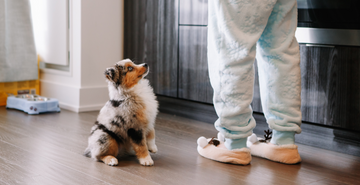Introduction: Welcome to TinyPetPaws, where the journey to a well-behaved and happy pet begins! Training your furry friend doesn't have to be a daunting task; in fact, it can be an enjoyable and rewarding experience for both you and your pet. In this blog post, we'll delve into the world of positive reinforcement, sharing training tips and heartwarming success stories that highlight the effectiveness of this gentle approach to shaping desired behaviors in pets.
Section 1: The Power of Positive Reinforcement Positive reinforcement is a training method that focuses on rewarding desired behaviors to encourage their repetition. This approach not only fosters a strong bond between you and your pet but also makes the learning process enjoyable. By using treats, praise, and affection as rewards, you can guide your pet toward becoming a well-mannered and content companion.
Section 2: Setting the Stage for Success
A. Start Early: Begin training your pet as early as possible to establish good habits and behaviors from the start. Puppies and kittens, in particular, are like sponges, ready to soak up new knowledge.
B. Consistency is Key: Consistency in commands and rewards helps your pet understand what is expected. Ensure that all family members are on the same page with commands and rewards to avoid confusion.
C. Patience and Positivity: Training takes time, so be patient and stay positive. Celebrate small victories, and don't get discouraged by setbacks. Your pet will pick up on your positive energy and respond more willingly to training sessions.
Section 3: Training Tips for Common Behaviors
A. Basic Commands:
- Teach essential commands like sit, stay, and come using treats and praise.
- Gradually increase the difficulty of commands as your pet becomes more proficient.
B. Leash Training:
- Use positive reinforcement to reward loose leash walking.
- Reward your pet for walking calmly by your side, gradually extending the duration of walks.
C. Potty Training:
- Reward your pet for eliminating in the appropriate spot.
- Establish a consistent schedule for bathroom breaks and reward successful trips outdoors.
D. Socialization:
- Expose your pet to various people, places, and other animals.
- Reward calm and positive interactions to encourage socialization.
Section 4: Success Stories
A. Lucy's Tale of Transformation: Lucy, a rescue dog with a troubled past, blossomed through positive reinforcement. By rewarding her for calm behavior and ignoring negative actions, Lucy learned to trust and embrace a loving home.
B. Felix the Fearful Feline: Felix, a shy kitten, overcame his fear of new people through positive reinforcement. Treats and gentle praise helped him associate strangers with positive experiences, turning him into a sociable and confident cat.
Section 5: Additional Resources For pet owners looking to delve deeper into positive reinforcement training, TinyPetPaws offers workshops, online resources, and expert advice. Our goal is to support you in creating a positive and enriching environment for your furry friend's learning journey.
Conclusion: At TinyPetPaws, we believe that every pet has the potential to be a well-behaved and delightful companion. By incorporating positive reinforcement techniques into your training routine, you're not just shaping behaviors – you're building a strong, trusting bond with your pet. Celebrate the small victories, relish the training moments, and watch as your pet transforms into the well-mannered and happy companion you've always envisioned. Happy training!





